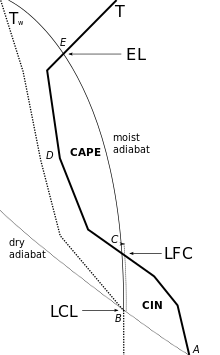Level of free convection
The level of free convection (LFC) is the altitude in the atmosphere where the temperature of the environment decreases faster than the moist adiabatic lapse rate of a saturated air parcel at the same level.

The usual way of finding the LFC is to lift a parcel from a lower level along the dry adiabatic lapse rate until it crosses the mixing ratio line of the parcel: this is the lifted condensation level (LCL). From there on, follow the moist adiabatic lapse rate until the temperature of the parcel reaches the air mass temperature, at the equilibrium level (EL). If the temperature of the parcel along the moist adiabat is warmer than the environment on further lift, one has found the LFC.
Since the volume of the parcel is larger than the surrounding air after LFC by the ideal gas law (PV = nRT), it is less dense and becomes buoyant rising until its temperature (at E) equals the surrounding airmass. If the airmass has one or many LFC, it is potentially unstable and may lead to convective clouds like cumulus and thunderstorms.
External links
- "SKEW-T: A Look at LFC". www.theweatherprediction.com.
- "Level of free convection (LFC)". Glossary of Meteorology. American Meteorological Society.